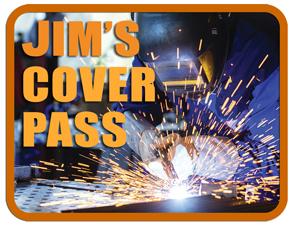Senior Company Trainer
- FMA
- The Fabricator
- FABTECH
- Canadian Metalworking
Categories
- Additive Manufacturing
- Aluminum Welding
- Arc Welding
- Assembly and Joining
- Automation and Robotics
- Bending and Forming
- Consumables
- Cutting and Weld Prep
- Electric Vehicles
- En Español
- Finishing
- Hydroforming
- Laser Cutting
- Laser Welding
- Machining
- Manufacturing Software
- Materials Handling
- Metals/Materials
- Oxyfuel Cutting
- Plasma Cutting
- Power Tools
- Punching and Other Holemaking
- Roll Forming
- Safety
- Sawing
- Shearing
- Shop Management
- Testing and Measuring
- Tube and Pipe Fabrication
- Tube and Pipe Production
- Waterjet Cutting
Industry Directory
Webcasts
Podcasts
FAB 40
Advertise
Subscribe
Account Login
Search
Jim’s Cover Pass: 3 simple steps to enhance weld quality
How fabrication shops can fight complacency to improve welds
- By Jim Mosman, AWS, CWI/CWE
- November 27, 2019
- Article
- Arc Welding

There are simple steps that job shops can use to fight complacency in an effort to improve weld quality. Getty Images
Q: My company is in the process of restructuring our welding department. Our goal is to enhance weld quality and productivity as we move into the new year. Where would be a good place for us to start?
A: Many companies reach a plateau with welding quality because they become complacent and rely on processes simply because, as they put it, “that is how we have always done it.” To avoid this, look at reviewing or installing three items into the production process before you implement any new ideas.
First, does your company use work instructions? This is a document that follows the job order throughout the production process. It includes material acquisition, the required number of parts, processes involved, along with inspection stops and details at each step. Including a signoff with a date and time stamp at each step helps production flow analysis through the manufacturing process.
Along with these work instructions, you should include the print or package of prints that correspond with each operation. This may be as simple as one print for a single part, or it may include a series of detailed assembly drawings. The work instructions would then identify and reference specific details. For example, Print No. 14302, Reference Weld A should be completed and inspected before Welds B, C, D, and E.
Finally, add a qualified welding procedure specification (WPS) to the shop packet for each welding process. This will identify the essential variables and procedure limits. Many weld projects will require several WPSs throughout the manufacturing process or assembly. Your welding technicians should understand the WPS and be qualified to produce the required weldments.
Everything that your company manufactures and/or welds should include:
- A detailed set of work instructions.
- Corresponding prints.
- Qualified WPSs for every required weld available to the technicians.
Installing and using these three documents will improve quality control procedures. As a result, your production quality will increase and your employees will have a better understanding of the company’s expectations.
About the Author

Jim Mosman, AWS, CWI/CWE
Lincoln Electric Education Division
About the Publication
Related Companies
subscribe now

The Welder, formerly known as Practical Welding Today, is a showcase of the real people who make the products we use and work with every day. This magazine has served the welding community in North America well for more than 20 years.
start your free subscription- Stay connected from anywhere

Easily access valuable industry resources now with full access to the digital edition of The Fabricator.

Easily access valuable industry resources now with full access to the digital edition of The Welder.

Easily access valuable industry resources now with full access to the digital edition of The Tube and Pipe Journal.
- Podcasting
- Podcast:
- The Fabricator Podcast
- Published:
- 04/16/2024
- Running Time:
- 63:29
In this episode of The Fabricator Podcast, Caleb Chamberlain, co-founder and CEO of OSH Cut, discusses his company’s...
- Trending Articles
Sheffield Forgemasters makes global leap in welding technology

ESAB unveils Texas facility renovation

Engine-driven welding machines include integrated air compressors

How welders can stay safe during grinding

The impact of sine and square waves in aluminum AC welding, Part I

- Industry Events
16th Annual Safety Conference
- April 30 - May 1, 2024
- Elgin,
Pipe and Tube Conference
- May 21 - 22, 2024
- Omaha, NE
World-Class Roll Forming Workshop
- June 5 - 6, 2024
- Louisville, KY
Advanced Laser Application Workshop
- June 25 - 27, 2024
- Novi, MI



























